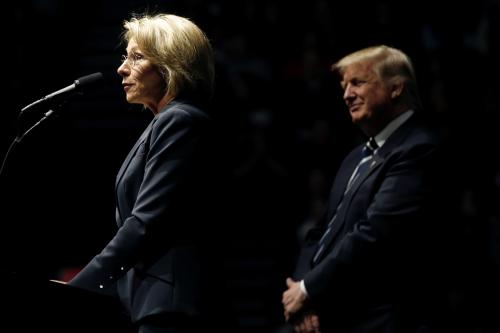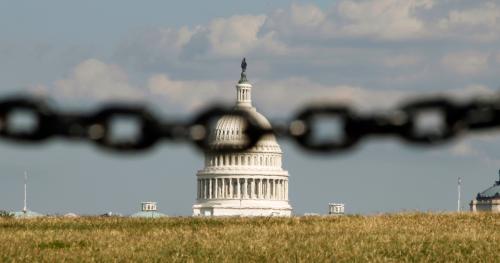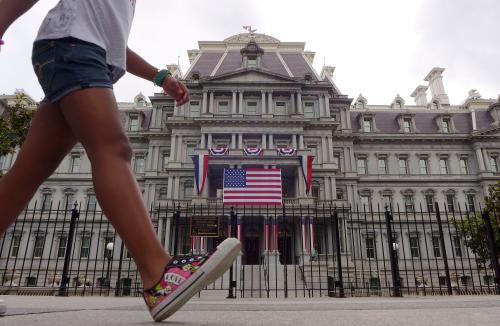With the atypical presidential campaign and the Olympics grabbing headlines this summer, some fascinating developments of ESSA implementation may have slipped under the radar. Between May 31 and August 1, the Department of Education (ED) received a staggering number of comments regarding its proposed regulations to implement the Every Student Succeeds Act (ESSA): just over 21,000.
As you might imagine, many of these comments were not written to thank ED for its hard work in implementing the new law. To the contrary, many commenters criticized the Department’s proposed regulations.[1] Does this mean that ED will admit defeat and revise its proposed rules substantially? Maybe, but not necessarily.
Breaking down the comment deluge
First, let me provide some details on the process underway. ESSA requires the Department of Education to engage in negotiated rulemaking to implement the Act, which means, in part, that ED must publish proposed rules and invite the public to comment on them. After the so-called “notice and comment” period ends, ED issues a final draft rule, the Office of Information and Regulatory Affairs (OIRA) reviews it, and once approved by OIRA, the final rule takes effect with the force of law.[2] This is a standard procedure which ED was required to follow when implementing ESSA’s predecessor, the No Child Left Behind Act of 2001.
What is surprising about the recent ESSA notice and comment period, however, is the sheer volume of comments submitted. Individuals and organizations submitted just over 21,000 comments between May 31 and August 1, 2016. Compare this to NCLB, which received 700 comments. In other words, the Department of Education received roughly 30 times more comments on ESSA than on NCLB.
There is reason to believe that a hearty share of these comments are critical of ED’s proposed rules. More than one-third of the comments on ESSA (over seven thousand) consisted of language from a form letter provided by the National Education Association (NEA), the nation’s largest teacher’s union. The NEA has been vocal about their opposition to some of ED’s proposed accountability regulations, and the form letter reflects these critiques. Over six hundred people wrote in using a template provided by the Network for Public Education (NPE), whose President is Diane Ravitch, a former Assistant Secretary of Education and a vocal critic of high-stakes tests and charter schools. The NPE language did not mince words, opening with: “I oppose the following proposed regulations as contrary to the language and spirit of ESSA and because they will impose damaging and overly prescriptive mandates on our public schools.”
Many commenters mentioned the Common Core. Almost two thousand commenters wrote the following: “No Backdoor Common Core! Stop this regulation now!” Just over one thousand commenters wrote in using this strongly-worded language: “This regulation goes behind the backs of Congress and the American people. Congress stopped Obama from forcing Common Core on our schools. And this regulation allows him to ignore them and the law. That’s why I’m asking you to stop this regulation now.”[3]
One might argue that submitting a form letter is not time-consuming and therefore does not send a particularly strong or meaningful signal to ED. In that case, these comments would have little bearing on ED’s decisions about whether and how to revise the proposed rules. But no matter how low-cost the strategy, submitting a form comment or letter indicates agreement with an organization’s platform, or more informally, with a particular policy position. The NEA appears to have been particularly successful in using this strategy. When one-third of all comments endorse the NEA’s critiques of ED’s proposed regulations, the aggregate signal may send a powerful message indeed.
How to interpret opposition to the Department of Education’s draft regulations
What explains this outpouring of public comments to ED’s draft regulations? If ESSA were passed on a party-line vote, like the Affordable Care Act, perhaps we might expect the losing side to vent frustration during the comment phase. But this is not the case. Like NCLB, ESSA is a bipartisan law that passed with few detractors from either party.[4] Both laws impose substantial changes from the previous legislative status quo, but NCLB was highly prescriptive compared to its predecessor, while the opposite is true, of course, for ESSA. It may be that NCLB’s prescriptive nature, combined with then-Secretary of Education Rod Paige’s 2002 pledge to implement the law as written, decreased the potential to influence implementation through rulemaking. In contrast, as written, ESSA leaves many decisions about accountability and measuring school performance up to the states but still leaves oversight authority to ED, leaving plenty of room for interpretation for the scope of that authority. The high volume of comments may reflect the sense among all interested parties that the implementation period offers a narrow but important window to influence what ESSA means in practice.
Do all of these critical comments have any influence on implementation? In short, the Department of Education is likely in the process of making some difficult decisions. ED is not legally bound to revise the proposed rules such that they reflect the feedback received during the notice and comment period. This means that ED could submit final rules to OIRA that largely ignore opposition to ED’s original proposals.
Doing so, while technically possible, seems unlikely, as this move would further mire ED in allegations of bureaucracy run amok. Officials in ED have a significant stake in maintaining the public perception of legitimacy. Flouting the public pushback to its proposals would be a risky endeavor that may trigger more congressional oversight, decreased funding as approved by Congress, or renewed calls for ED’s abolishment (while an unlikely event, this kind of publicity could not possibly help ED maintain and implement its authority as it seeks to implement the biggest change to federal education policy in 15 years). Should we conclude that the Department of Education has no option but to comply with public pressure and walk back its controversial proposed regulations? Not quite.
Dr. Rachel Potter argues that agencies and departments can capitalize on the rulemaking process to release rules when the timing is politically beneficial. Specifically, she finds that departments can “slow-roll” promulgation of final rules after the notice and comment period closes. If a department fears Congress may respond negatively to a final rule, the department may wait for a friendlier political environment to submit the final draft rule to OIRA for review (or, in cases when OIRA does not review a rule, the department can drag its feet on publishing the final rule). The implications are important: departments can create political cover for themselves through delayed release of final rules.
With the presidential and midterm elections around the corner, is it possible that the Department of Education will wait until the elections to finalize rules under ESSA? This strategy may lead to finger-pointing about “gaming” the system. But on the other hand, there are certain to be more dramatic headlines in November that may distract potential critics. Thus far, ED has sent only one proposed rule to OIRA related to the “supplement not supplant” provision of Title I.[5] Other proposed rules relating to school dashboards, the minimum size for subgroups, and indicators of school quality are still in the pipeline, but safely out of the public eye for now.
Editor’s note: This post was updated on December 8th, 2016 to reflect corrections to the number of comments submitted using form letters.
[1] I should note here that these observations are based on exploratory searches of the comments and reflect initial impressions.
[2] Not all regulations are subject to OIRA review; see here for further explanation of the rulemaking process and OIRA’s role.
[3] These two Common Core comments are clearly form letters, although I have not been able to identify the organization that created them.
[4] Notably, roughly twice as many Republicans voted against ESSA as they did against NCLB. For NCLB the vote breakdowns by chamber are: House vote: 381-41 (33 R, 6 D vote nay), Senate vote: 87-10 (6 D, 3 R vote nay). For ESSA: House vote: 359-64 (64 R nay, 0 D nay), Senate vote: 85-12 (12 R nay, 0 D nay).
[5] OIRA finished its review of this particular proposed rule on August 11, although the rule has not yet been published.







Commentary
A flood of criticism on proposed ESSA regulations, but will anything change?
August 25, 2016